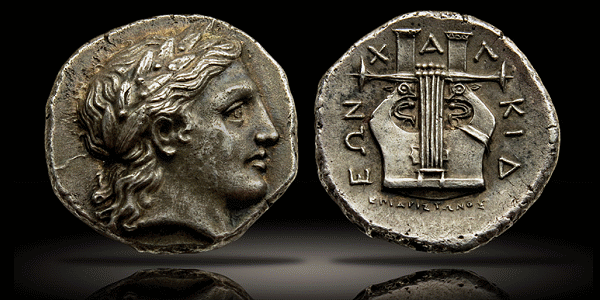 Fearful of Athens and the growing power of the Macedonian Kingdom, Olynthus and the other free cities of the Chalcidice banded together in 432 BCE, forming the Chalcadian League as a defensive coalition. Athens failed to break up this union due to its focus on the Peloponnesian War and its general disinterest in the region, helping solidify the strength of the League.
Fearful of Athens and the growing power of the Macedonian Kingdom, Olynthus and the other free cities of the Chalcidice banded together in 432 BCE, forming the Chalcadian League as a defensive coalition. Athens failed to break up this union due to its focus on the Peloponnesian War and its general disinterest in the region, helping solidify the strength of the League.
The capital was placed at Olynthus on a peninsula of northern Ancient Greece, on the shores of the Aegean Sea. The name “Olynthus” originates from the Greek olunthos, a fig which matures early, as this fruit was plentiful in the area.
The Chalcadian League was at the height of its power in the late fifth century BCE but soon became the center of conflict. In 393 BCE, Amyntas III of Macedonia was under attack by the Illyrians and temporarily transferred territory to Olynthus for protection. When he regained control, the League refused to return his lands and he called upon Sparta to intervene. At the same time, there was unrest in the League and some members claimed that they were being forced to remain in the League against their will.
This forced Sparta to act and after a lengthy war, the cities were subjugated by Sparta in 379 BCE, with their power divided. Despite being summarily defeated, the Chalcadian League quickly began to regain power, which frightened Philip II of Macedon. To ensure his continued success in the region, Philip proactively attacked Olynthus, destroying the city in 348 BCE and disbanding the League permanently.
This coin was minted at Olynthus during the period in which the Chalcadian League was under Spartan oversight but regaining strength. They minted their own silver coinage on the Macedonian standard, functioning as legal tender within all cities of the League.
The overall design elements remained consistent but style varied substantially over time. This coin’s depiction of the head of Apollo is a superb example of die engraving, remarkable for the strength and beauty of its style. These heads served as the predecessor for the portraits on the gold staters of Philip II.
The reverse depicts a professional version of the lyre, a kithara. As opposed to the standard lyre, which was predominately used as a folk instrument, the kithara was reserved for skilled musicians called kitharodes and the singers of Greek epic poetry. The name “guitar” is derived from the Greek kithara.
The kithara was an attribute of Apollo and symbolized wisdom. It resonates in its box-shaped body which holds two parallel arms connected by a crossbar. Depending on the type and desired complexity, up to a dozen strings could be attached. It was played vertically, plucked with a plectrum in the right hand with the left hand damping the strings.
According to mythology, the kithara was invented accidentally by the Greek messenger god Hermes, Apollo’s brother. Mere hours after being born, Hermes immediately embarked upon a journey to steal oxen from his brother who was away from his herd.
During his trip, Hermes brushed against a turtle shell on the ground, and thought to stretch seven strings across it. He plucked them and was instantly able to play exquisitely, creating the kithara.
After reaching the herd, Hermes attempted to steal 50 oxen but Apollo discovered the theft and the brothers began to quarrel, only to be interrupted by their father Zeus. To repay his brother, Hermes offered Apollo his kithara. Having only ever heard a standard three string lyre before, Apollo was so enthralled by the beautiful sound that he not only forgave Hermes, he granted him full dominion over all flocks and herds.
Hermes agreed and formally became the god of herdsmen, swearing to never steal the kithara. Apollo fully devoted himself to the art of music and was said to bring stability and order into chaos with his playing.
This coin resided in the collection of René Baron, the head of a French hospital, who focused on collecting artistic and historic coins.
Olynthus, 355-352. Chalcidian league, 432-348. Tetradrachm, silver, 14.40 g. Obv. Laureate head of Apollo to right, his hair flowing down the back of his neck / Rev. Kithara with five strings; below, επι αριστωνοσ. Traité IV, 942; BMC Macedonia 68, 10; SNG ANS 496-497; SNG Copenhagen – ;AMNG III/II, 85, 8, pl. 17, 12; D.M. Robinson, P.A. Clement, groupe V, 130 (A80-P111), pl. XVI, 130 (same dies); Boston 582 (same dies). Beautiful style, finely toned, and well centered. Extremely Fine.
Ex. René Baron Collection, acquired at Crédit de la Bourse, Paris, March 1990



